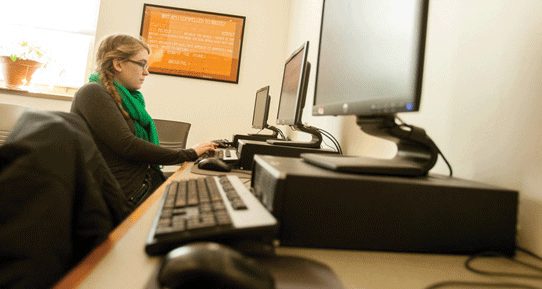Lutman Emphasizes the Importance of Technology in Providing Constructive Feedback

Professor Lutman cites the function and benefit of Google Docs in providing feedback.
Technology used in a classroom setting varies significantly between professors and disciplines. On Tuesday, February 7, director of the Writing and Speaking Center Jenn Lutman advocated for a shift away from using pen-and-paper practices as well as Moodle during the brown bag titled “Supporting Student Writing with Feedback Using Google Drive.” The discussion facilitated a reflection between students and faculty concerning their personal experiences using technology and how to positively shape the classroom experience.
Both Moodle and Google Drive serve as platforms to provide professors and students with a comprehensive space to communicate. Professors often post necessary information on Moodle for their classes to access, such as the course syllabus and required readings. In an effort to facilitate discussion, many professors require students to submit written assignments to the class and offer responses on work written by their peers. Lutman argued that Google Drive is more relevant than Moodle in life beyond Colgate and offers a more navigable experience.
“In my professional life, I use Google Docs and drive to trade documents and collaboratively work on a common document. I know we aren’t the only one’s doing this in our professional lives. As a writing professor, I thought: use what students already know how to use and what they are likely to be doing in the future,” Lutman said.
Lutman requires her students to consistently offer feedback on each others’ work in an effort to motivate them and improve their communication skills. While Moodle offers an interactive platform to thread discussion questions and responses, it is challenging for her as a professor to track individual improvements throughout the semester. Moodle, unlike Google Docs, does not offer a way to view all entries at once. Moodle entries are often time sensitive and as a result, each assignment must appear under a different tab. Through Google Docs, however, professors can create a document where students can engage with each other and add additional assignments to just one location all semester long.
Lutman believes the most revolutionary part of using Google Docs and Drive is the immediacy of exchange.
“Students can easily share [Google] documents and also insert comments on their drafts. Through Google Docs, we can easily have an exchange, because I can respond to questions and easily show examples of how to make a sentence more efficient or cohesive. Instead of using a lot of time explaining this in person, I can make a suggestion and have the student review and accept my comment,” Lutman said.
While many professors favor having students submit hard-copies of their papers, inefficiencies can result from this form of technology. One common problem occurs when students cannot read the handwriting of the professors who are commenting on their papers. Google Docs avoids this uncomfortable situation by providing an easily legible and accessible platform.
“I can explain very simply what I would like changed, and students can see it concretely,” Lutman said.
Senior Carolina Batista echoed the importance of having efficient communication between professors and students.
“I definitely prefer doing things online because of the clear and legible comment section,” Batista said.
Google Drive, while effective, still has some shortcomings. When compared to Microsoft Word, Google Drive does not offer the same wide range of fonts and clean organization style. Furthermore, formatting differences occur when adding footnotes and endnotes. Although admitting these shortcomings, Lutman believes that the enhanced communication abilities of Google Drive outweigh the negatives. This is Lutman’s third semester using Google Drive, and she plans to continue learning about the program and making the platform more user friendly for her students whom she is providing feedback to.
“I know what I’m doing is working so far in the classroom, but I know I still have a lot to learn about using technology in the classroom,” Lutman said.
Students in attendance agreed with Lutman on the importance of using the form of technology. Senior Astonya Ambrose advocated on behalf of online submissions.
“I like turning things in online, because when you have paper copies, you have to figure out when you have time to print and also you have to worry about if the printer will even work in the library, because the printer never works in the library. Then you have to figure out other places you can go to print and rush to your classroom,” Ambrose said.
The brown bag was co-sponsored by The Center for Learning Teaching and Research (CLTF) and Academic Technologies, and it was from the series titled “Teaching with Technology.” More technology-related events will be held later in March and throughout April.



